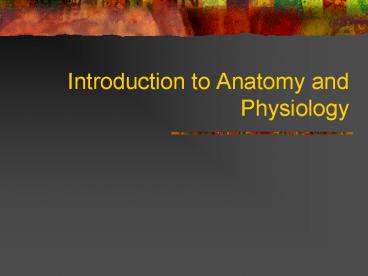Introduction to Anatomy and Physiology - PowerPoint PPT Presentation
1 / 14
Title:
Introduction to Anatomy and Physiology
Description:
Introduction to Anatomy and Physiology Anatomy and Physiology Anatomy ana = tome = Morphology Physiology physis = logos = Why study them together? – PowerPoint PPT presentation
Number of Views:500
Avg rating:3.0/5.0
Title: Introduction to Anatomy and Physiology
1
Introduction to Anatomy and Physiology
2
(No Transcript)
3
(No Transcript)
4
Anatomy and Physiology
- Anatomy
- ana
- tome
- Morphology
- Physiology
- physis
- logos
- Why study them together?
- Principle of Complimentarity
- Form follows function
- Hand formed with jointed fingers in order to grab
and hold. - Bones function to support and protect therefore
they are formed from rigid minerals. - What professions would need to have a background
in A P?
5
Anatomy and Physiology Structure meets Function
- Anatomy Structure of the human body different
levels of the science of anatomy - Gross
- Regional
- Systemic
- Surface
- Microscopic
- developmental
6
- Physiology looks at HOW specific systems work
- Focuses on cellular and molecular levels
- Uses other branches of science
- Subdivisions
- Neurophysiology
- Renal physiology
- kinesiology
7
Levels of Structural Organization
- Hierarchy of structural design to the human body
(figure 1.3 p. 4) - Chemical (atomic)
- Cellular
- Tissue
- Organ
- Organ system
- Organism
8
Characteristics of Life p. 4
- Consider traits that humans share with other
organisms. - Movement
- Responsiveness
- Growth
- Reproduction
- Respiration
- (contd)
- Digestion
- Absorption
- Circulation
- Assimilation
- excretion
9
Maintaining Life p. 5
- Requirements
- heat
- food
- water
- oxygen
- pressure
- Homeostasis
- Ability to maintain a constant internal
environment - Done through a number of self-regulating control
systems
10
Elimination Why
- Absorption
- Stomach
- Kidneys
- Excretion
- Urinary system
- Eliminate one of the words from the list and
explain why it does not belong.
11
Characteristic Body covering Organ System 1.integumentary Function 1.Protect underlying tissue, regulate body, temp, house sensory receptors
Support Movement 1.Skeltal system 2.Muscular system 1.Provides framework and protects 2.Generates heat, maintains posture, movement
Integration Coordination 1.Nervous system 2. Endocrine System 1. Takes in data, processes data 2. Provides chemical messengers
Transport 1.Cardiovascular system 2. Lymphatic System 1. Transports gases, nutrients, and wastes 2. Reabsorbs tissue fluid
Absorption Excretion 1.Digestive system 2.Respiratory system 3. Urinary system 1.Breaks down nutrients 2. Gas exchange 3. Remove waste and maintain electrolyte balance
Reproduction Female Male 1. Reproductive system 1. Produces new organism
12
Organization of the Human Body
- Define the following terms. Terms are located on
pp. 8-11. - Axial
- Appendicular
- Parietal
- Visceral
- Pleural membranes
- Pericardial membranes
- Peritoneal membranes
- The following terms are listed on p. 14.
- Anatomical position
- Superior
- Inferior
- Anterior
- Posterior
- Medial
- Lateral
- Proximal
- Distal
- Superficial (peripheral)
- Deep
13
Rules for drawings.
- Each drawing should be
- Head each sheet with your name, due date, and
period - Done in pencil
- Colored
- On a separate piece of paper
- Labeled with the figure number, page number,
title and description. - COMPLETE
14
Draw, label, and turn in the following
- Figure 1.8 (a) and (b) p. 9 Major body cavities.
- Figure 1.9 p. 10 Cavities within the head
- Figure 1.13 p. 15 Body sections
- Figure 1.16 p. 17 (a) and (b) Body regions































